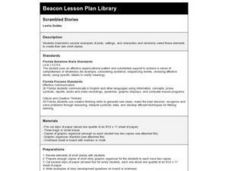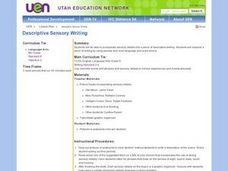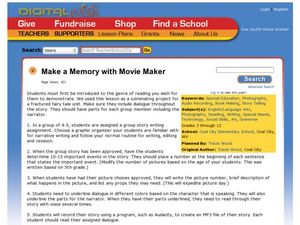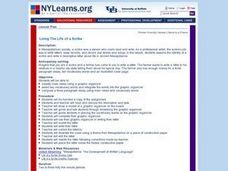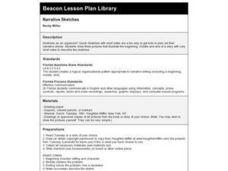abcteach
Flowers for Algernon, by Daniel Keyes
Looking for materials to accompany your study of Flowers for Algernon, by Daniel Keyes? Look no further! Included here is everything you need to go alongside your unit: worksheets, graphic organizers, writing assignments, an assessment,...
Curriculum Corner
I See a School
Enthusiastic readers report on a book detailing what it's about and their favorite part with a picture-based writing template. A nonfiction version takes a step further to highlight what the pupil learned, and a fiction version showcases...
Curated OER
Writing to Persuade
Students discover effective writing techniques to create persuasive essays. For this writing lesson, students investigate ways to express facts and points of view through persuasive essays. Finally, the students write their own...
Curated OER
"I Can” Common Core! 6th Grade Writing
It is impossible to know whether one has reached a goal without first knowing the goal. Help your sixth graders reach all the Common Core writing standards by giving them a checklist written in language they will understand. As you teach...
Curated OER
Narrative Prompt
Second graders are introduced to the style of a narrative writing. After being read a story, they use a graphic organizer to plan their writing. With a partner, they share their ideas and decide on one topic to write about. To end the...
Curated OER
Scrambled Stories
Character development, setting, and plot? Sounds like the makings of a good narrative story. Young authors read and analyze several narrative examples, and then they use what they know to pen an original composition. They work both in...
Curated OER
Descriptive Prompt: Precise Language
Incorporate sensory details into a piece of descriptive writing. First, elementary and middle schoolers improve a piece of writing by using precise, vivid language, as well as appropriate word choice. They then listen to a variety of...
Curated OER
A Creative Presentation
Bring writing to life with this lesson in which elementary and middle schoolers create a display of the imagery they identify in a series of Gary Paulsen books. They read the suggested materials, identify imagery and descriptive...
Curated OER
Narrative Cartoons
Students create narrative cartoons based on the activities of the Peace Corps. For this narrative cartoons lesson plan, students create comic strips where they draw and write about various activities that the Peace Corps is involved in.
Curated OER
Using Word Processing to Create Graphic Organizers
Students create a graphic organizer and instructional rubric using word processing software. They conduct Internet research at the History Alive website, and publish an essay.
Curated OER
Make a Memory with Movie Maker
There is nothing more exciting than allowing learners to express themselves through a creative medium. In groups, they write narrative stories, focusing on building a strong storyline and dialogue. Next, they transform their stories into...
Digital Writing and Research Lab's – Lesson Plans
Teaching Close Reading through Short Composition/Revision
This activity may have writers evaluate short compositions, but their subjects are quite tall: great Americans. Pupils read one another's compositions and closely examine how specific phrases and diction contribute to shaping American...
Curated OER
Living The Life of a Scribe
Students write a descriptive letter about life in ancient Mesopotamia. Through video streaming, students discover the history of Mesopotamia. They assume the role of a scribe and compose a three paragraph essay using main ideas and...
Calculated Industries
Army Survival
Intended as a reference tool for US Army personnel, this application can be used in a classroom that is studying historic and current wars or as part of an outdoor education or wilderness survival course. Some of the subjects addressed...
Curated OER
Creature From The Deep
Students become familiar with oceanography terms by writing an oceanography horror story.
Curated OER
Narrative Sketches
Second graders read "Tuesday" for inspiration. They draw three pictures that illustrate the beginning, middle and end of a story with very short notes to describe the sketches. They use the sketches as an organizer to use before writing...
Curated OER
Outline a Travel Narrative
Fourth graders are taught how to outline a fictional narrative essay. They review the definition and structure of narrative essays. Students use the activity to brainstorm specific ideas for narrative essays. They are given a...
Curated OER
Blank Story Board
While this resource doesn't look like much at first glance, it has the potential to become anything your class can dream up. It is a blank story board template which you can print and use for a wide variety of lessons. Tip: Have learners...
Curated OER
Plan Your Unexpected Journey
Leave your hobbit hole and start an adventure with J. R. R. Tolkien's timeless tale of dwarves, dragons, and hobbits.
Santa Ana Unified School District
Getting to the Core: Early American Poets
How do poets convey emotion and represent their views of life? Pupils learn more about Whitman and Dickinson through the unit and analyze their bold reinvention of craft and style for poets to come. Looking at classic pieces such as...
Curated OER
The Rumpelstiltskin Story
Why didn't Rapunzel's hair stop growing? Why did it take the fairy godmother so long to intervene in Cinderella's affairs? Young writers consider unanswered questions like these and compose news articles investigating the true story...
Pittsburgh Ballet Theatre
West Side Story Suite and In The Night Fancy Free
West Side Story and Romeo & Juliet—two classics in their own rights that help young literature lovers better analyze different works. Learners research and compare the characters and story elements of West Side Story and Romeo &...
Curriculum Corner
Fiction Graphic Organizers
Analyze a fictional text with a four-page packet that explores a story's main character and moral, challenges scholars to ask and answer questions about the text, and to create a story map.
Teach-nology
Author's Purpose
Challenge your class to find the three purposes for writing. After they read three short passages, kids note whether the author's purpose was to inform, persuade, or entertain.







